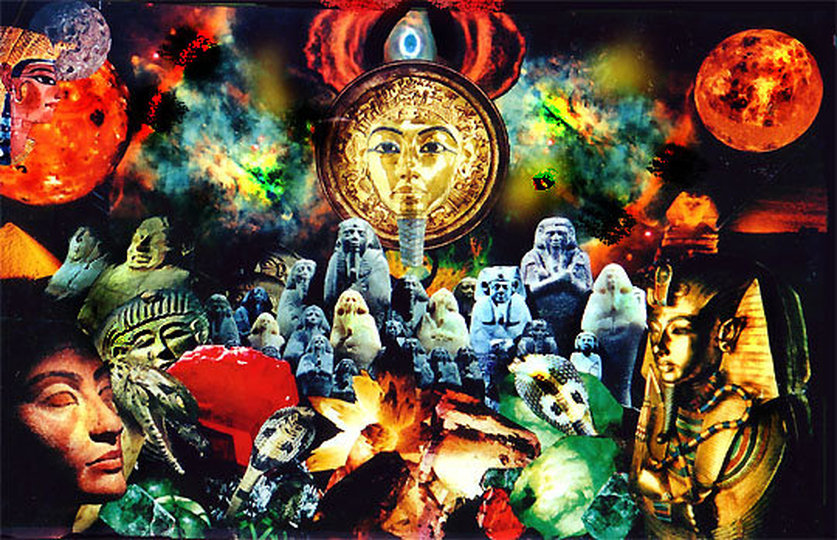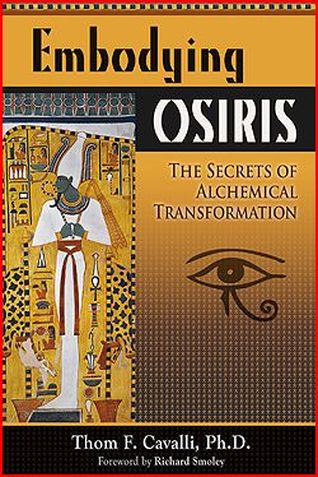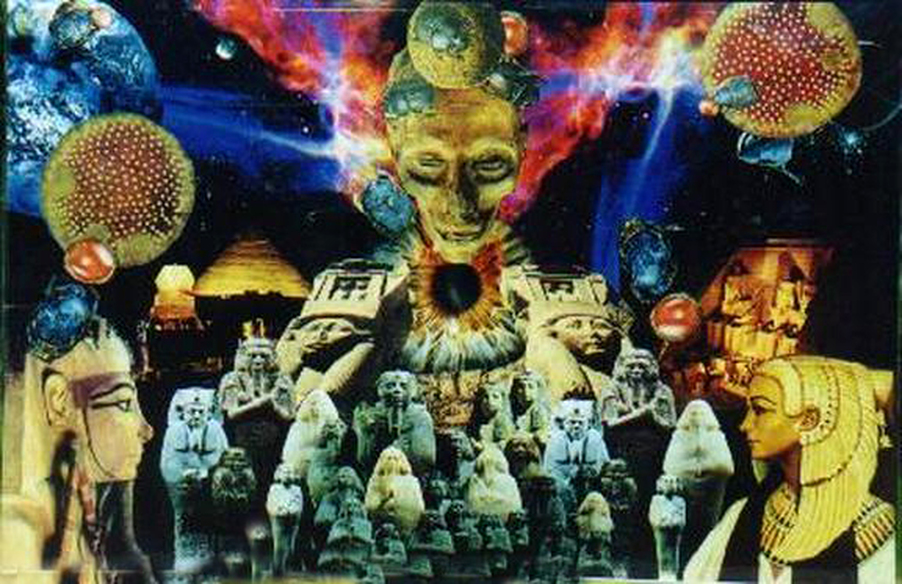Embodying Osiris
Review for Alchemy Journal
EMBODYING OSIRIS: The Secrets of Alchemical Transformation, by Thom F. Cavalli
Iona Miller
"The road to the unconscious is not a one way street; rather, it is a living part of the psyche that responds in its own mysterious way to all that happens in our conscious lives. Building an image of a lost god revives ancient memories, and in this way Osiris is psychologically recalled and brought back to life."
Life, Death & Immortality
Egypt remains a realm of mystery as does the psyche. The ancient land of Egypt is not the same as the eternal sunshine of the Egypt of our modern minds. We can never "embody Osiris" with concepts, but only through fully entering the inherent mystery of alchemical processes that define the rhythms of life.
In this insightful Jungian volume, Dr. Thom Cavalli is correct in insisting that "empathic engagement of the god on an imaginal and physical level" is required. In this way a more meaningful life springs from death, through a "body" of integrative experience. The Egyptians presumed "death" was not the only option.
Universal Solvent
There is a generic process in nature and consciousness which dissolves and regenerates all forms. Inherently unpredictable holistic repatterning is the essence of transformation. The dissolution (solve) of death can be followed by a sublimation (coagula) that releases the Ultima Materia of the Soul. Coagulation transcends heaven and earth, producing a transcorporeal incarnation that can survive both. Through this Body of Light we learn to exist at all levels of reality, fusing individual and universal fields.
In Anatomy of the Psyche, analyst Edward Edinger describes seven major aspects of solutio symbolism, which recapitulate the cycle of Osiris: (1) return to the womb or primal state; (2) dissolution, dispersal, dismemberment; (3) containment of a lesser thing by a greater; (4) rebirth, rejuvenation, immersion in the creative energy flow; (5) purification ordeal; (6) solution of problems; and (7) melting or softening process.
The most undesirable outcome of any Egyptian life was to become nonexistent. But, we can resurrect that portion of the Osirian spirit that we carry in our unconscious. We can resurrect the magical names of Osiris: 'Wenennefer" or "Wennofry", "joy of existence" or "beautiful being". Osiris is a realization -- a Way of being, not simply a philosophical worldview.
Epic Ordeals
The consensus of all authors on the subject of Osiris may be "dead" wrong. Dynasties of priests, priestesses, and royals practiced the Royal Art. Cavalli claims there is scant evidence of abstracted philosophical thought among the ancient Egyptians. We don't know if they were having mystical experiences, but we know they consumed alcohol and drugs that altered their perceptions.
We will never know the felt-sense of Osiris in the Old Kingdom. There was no structural separation between thinking and doing. Cavalli calls the ancient Egyptian art “unconscious alchemy”. Maybe being closer to nature they grasped it with more immediacy, without cognitive dissonance or dissociation.
We share this ancient wisdom when we dive into our experiential depths. Does this subjective Jungian narrative of theories, dreams and myth illumine or inform our alchemical practice in a necessary way, or does benchwork provide our projections with a certain objectivity that promotes insight into universal processes? Adopting the so-called "spiritual" or "practical" approach depends on our essence.
As unconscious, Osiris is the paradoxical life/death ground where integrative impulses arise. His epic ordeals mirror our own. Perhaps the Jungians need alchemy for articulating psychic processes more than alchemy needs Jungian models. After all, benchwork went on for millennia without Jung's hermeneutics. Alchemy had its own ways of describing proto-scientific interpretations of phenomena. Still, Jung and Cavalli's categories, metaphorms and mytho-poetic language broaden our descriptive vocabulary, helping us articulate the deep meaning of what we see in the vessel.
An alchemical mytheme exists on a higher level than simple narrative. There is a relationship between bundles of relations which produce meaning. They emerge from the structural oppositions of the alchemical process. The psychological approach is valuable and can add depth to practice if not taken literally or used to preempt what needs to emerge organically and experientially.
Applicants for the priesthood of Osiris entered the tomb alive to await his light. They spent the night in the coffin, entering their fear to achieve mastery. Left alone in the darkness of the crypt, the initiate in the sarcophagus felt the cold of the grave. Under sensory deprivation, the initiate experienced a life review or began to see colors and lights. Such illumination was recognized as the visionary light of Osiris. Some aspirants had conversations with Isis or Osiris. Others visualized themselves in the land of the dead, walking and talking with departed spirits and receiving special teachings from Osiris before a resurrection like those conducted in Mystery Schools today.
Zero Point / Dark Light
Embodying Osiris presents a belief system about a belief system of a belief system. It may speak to the psyches of today's audience and appeal to their spiritual desires, but it remains an interpretation that only hints at mystery. It fails to carry us into either the Old Kingdom or alchemical being as many practitioners define it. Still, Cavalli's luminous treatise helps our journey be Light and our lead turn to gold. Jung's brilliant interpretation and codification of alchemy remains just that. However, he renewed the relevance of alchemy in our modern lives.
Jung suggested we find language that unifies psyche and physics. Using a sub-quantum physics view, the downloadable "universal information field of Osiris" is directly available as the coherent biophotons of our living system, zero-point energy. The Egyptians had their Zep Tepi, home of all creational forces. From this "First Time" the gods move through the void continuously creating reality.
Zep Tepi is also embodied as an alchemist which makes him a Magician, Magi, Master, who can bend light to create illusion in the electromagnetic program or our reality. He is Thoth, (thought), "Lord of Magic and Time" - Hermes, 'Messenger of the Gods" – and, the enigmatic wizard Merlin, who disappears up an apple tree to mythic Avalon, seeking the secret of immortality and vowing to return.
Zep Tepi claims he will return at the end of this Cycle of Time through the alchemy of DNA and consciousness. He brings with him the secret keys to the gates of a sacred land or golden age, meaning a spiraling vortex of consciousness returning to higher frequencies of light and understanding. DNA, the Tree Of Life is a live vibrating structure, a shimmering waveform configuration, modulated by light, radiation, magnetic fields or sonic pulses.
For thousands of years, the Egyptians conducted genetic experiments in the quest for immortality. Only the pharaoh intermingled with the god as the conduit for all the people in ancient dynasties. That is a very different model than presuming such experiences are universally available to those who engage in the therapeutic process outlined by Jung with his alchemical metaphors and psychological practices. Alchemy calls its concrete result the Stone.
The Opening of the Way
"Osiris" is Greek for the sacred name 'Wasir". The Greeks also called him Typhon, "the passionate, titanic, reasonless aspect of the Soul." His adversary Set or Seth was/is the universal principle of destruction and dissolution. We cannot speak of Osiris apart from the rejuvenating processes of Isis (Aset), who complements and completes him.
Only those who live close to nature can unlock her secrets. The Egyptians themselves loved their world so much they considered their whole country a universal temple they wished to perpetuate in the afterlife. Is the perpetuation of an ideal life after death the ultimate? Fraser had a formulaic interpretation of Osiris as a tree spirit and fertility god, a symbol of "dying and resurrecting" plant life of an agricultural society. Mastering nature's secrets meant becoming like a god. But clearly this view, while not inaccurate, is reductionistic.
Color-coded Transformation Cycle
Interpretation of dynastic Egypt and the Osiris cult is riddled with Western religious and psychological bias. .A thousand books cannot convey its true essence. E. A. Wallis Budge wrote two exhaustive volumes on Osiris. Still, no extant Egyptian records confirm these scholarly deductions or illuminate their experiential levels. No one can read hieroglyphics forward, backward and inside out for all the sacred symbolism they encapsulate. R.A. Schwaller de Lubicz came far closer to describing the nuanced esoterics of the Egyptians. His writing "makes sense" of Osiris. Cavalli's volume makes it pertinent to each refreshing nanosecond of our existence.
Jungian psychology is "informed" by hermetics and uses its symbols and metaphors as benchmarks of the transformative process/goal. Active immersion in the "anima-ted" alchemical worldview binds us to the process. Wisdom is encoded in the fundamental perceptions of black, red, white, green and gold. Alchemy is a science/art wed to observation and experiment.
Spiritual & Practical
Alchemy opens the imaginal, the psychic dimension of reality, realm of depth. Energy/life/matter cannot be split into "organic" or "inorganic". Today, alchemy is divided into "spiritual alchemy" and "practical alchemy," but the Egyptians had no such artificial divisions. Jungians institutionalized this split to bolster their interpretation of psychic phenomenology, using alchemical homologues. At best, it is one level of lab work.
Rituals were recipes. The Egyptians were "hands on" artificers. Their alchemy was a collective social process, requiring a whole society for its execution. The proto-science of medieval alchemy turned the tables making alchemy an extremely private, even secretive encoded practice in which one experimented upon oneself, physically and spiritually. Its execution was idiosyncratic. Artists in action seamlessly weld thinking, doing and being, stimulating the creative flow of innovation.
The Egyptians noted the hidden processes of nature, such as desiccation and preservation of the body, and emulated nature to speed it up. They solved their problems with their hands. Their hands were not separate from their hearts and spirit; soul was not separate from body. Their experience of time was cyclic, not linear. Metallurgy, tanning, baking bread, and brewing still had their magic.
They kept their recipes secret, but it was no secret that their Pharaohs were being prepared for immortality. In preserving the corpse they perpetuated the soul. Perpetuating a Name by remembrance assured immortality. This Great Work went on long after the ruler left the realm of the living and was conducted by an elaborate support system. At death the pharaoh surrendered to the passive portion of the process, trusting his intention had been set in motion and the universe would conspire to make it so -- forever.
Radical Resurrection in the Womb of Space
Many ancient royals have been retrieved by archeologists and their corpses are still cared for while their names and deeds are noted and sung. Is this a testament to the continuing power of their heka (magic)? In loving their stories, we love them with remembrance. We perform the sacred act of Isis.
Modern conservation constitutes a sort of "second coming" for each mummy, though the cult of academia is quite different from their original priesthood. Their evolving society first merged the individual with the collective, then launched one representative into eternity as an archetypal symbol, merging individual with universal. Society served the redemptive function of the person who was the social glue of the kingdom. Later, mummification of wealthy but common people emulated this act on a broader scale. The priests developed a cottage-industry, duplicating their Book of the Dead instructions for all who could afford it.
Re-Membering Osiris
Human beings weave imaginal tales about the nature of nature, their experience and dreams. We still stave off our fears of death with hopes of eternal life when the existential fact remains that it is impossible for us to leave the sacred source field that undergirds both our corporeal existence and our potential immortalization in the virtual field, the groundstate of continuous creation.
We will never know if their ardent efforts granted the Pharaohs primordial awareness or not. We just change form -- and that may be the essence of alchemy. Our alchemy is kept alive by practice and open-ended questions and spiritual questing that keeps the transformative process flowing. The method works if we do. What we derive from it has everything to do with what we put into it.
A Jungian approach is not a requirement for alchemical practice, "spiritual" or otherwise. It is a valid approach with its own coherence. A book of this sort can probably help us articulate some of our experiences. It can also highlight where we might strongly disagree about our style of practice. Both resonance and cognitive dissonance add to our self-awareness.
Theory and Practice
None of this reduces the inherent value of Cavalli's book. He admits he does not take on the burden of unifying Egyptian life conceptually as it is beyond the scope of his practice. The scholarship and points he makes can help us in our daily lives as well as our transformative journey. Analytical psychology is a coherent system that produces objective healing and integrative effects.
The first rule of process therapy is not to "import" foreign notions and symbols into the system. We facilitate the emergence of inherent metaphors that alone create healing deeper than a "one size fits all" formulaic approach. We deepen the process through the childhood, ancestral, cultural and cosmological layers of the psyche, kindling the redemptive metaphor, the inner healer.
Remaining true to his profession as an analyst, Cavalli interprets one cult, (Osiris), in light of another, (Jungianism) to illuminate a third -- Alchemy. But whose "alchemy" is it? His "unpacking" of ideas interprets one belief system, with another belief system, calling it a third belief system that has evolved over the centuries to suit its own social, political and scientific environment.
Ultimately, "Jung" can be just another limiting model that conveniently codifies the one process into neat categorical boxes which must be explored via "active imagination". If today's alchemy mirrors this process it is not the fault of our art, but of ourselves -- a failure to launch our unfettered imagination in truly novel ways. Perhaps this is why we can only illuminate our search further by asking more open-ended questions that keep the Mystery if not our individual "Self" alive. Mystery can only be known by gnosis, revelation and grace. Alchemy helps us stand in this Mystery, embodying Osiris.
Sacred Knowledge
This Jungian interpretation is a narrative which is legitimately imaginal, yet its validity may not extended beyond its own cultural context. While Jung's ideas are widely accepted in Western culture, there is no consensus within psychology that his is the correct or only view, anymore than there is consensus in models of physics. The Standard Model is accepted despite its flaws because it "allows us to do work." Jung's theory has a similar relationship to the science/art of alchemy.
The One World of alchemy remains elusive in both psychology and physics, so we have no unified field theory. What we have are the models that guide our practice. The alchemy of Jung is not necessarily the alchemy of Osiris or Old Egypt. It may not even be representative of contemporary alchemical practice by anyone but Jungians. Further, contemporary lab work may have little in common with the immersive alchemical experience and processes of ancient Egypt that were necessarily tied to their culture.
In Jung's allegedly phenomenological model we find a repertoire of constructs or categories that may or may not relate -- archetypes, individuation, the "Self", psychological transformation. There is dissention among professional therapists about the relevancy or accuracy of such notions, though they have proven themselves invaluable for grasping and experiencing aspects of the unconscious (aka, "Osiris"). Certainly "reading the recipe" is not the same as "tasting the dish." But this may not be the alchemy of Egypt despite the nomenclature.
Is Alchemy Psychological?
Cavalli's last work was Alchemical Psychology and now he has written about a "psychological alchemy". What about labwork? Can we really substitute the therapeutic hour for the laboratory? Alchemy isn't only conceptual. Many practitioners of the royal art insist that the experimental side must be practiced in order to bring about its transformations by remaining true to the hands-on alchemical spirit. Is it unavoidable that we impose multiple layers of interpretations from alien societies, muddled by foreign worldviews onto the Egyptian foundation?
None of this is a criticism of Cavalli's scholarship, hermeneutics, nor healing methodology. Just as archeologists can only tell so much from digging up artifacts and interpreting archival material, psychologists can do no more. Such works may point us in the right direction, but the path itself is necessarily experiential. We cannot fully "embody Osiris" without the realization that he always undergirds our being, just as death informs life in the most fundamental way, giving life its edge and immediacy.



